Mathematical Perspectives (8104): History and Development of Geometry
VerifiedAdded on 2023/06/03
|9
|2886
|411
Report
AI Summary
This report provides a comprehensive overview of the history and development of geometry. It begins with a definition of geometry and its importance, then explores its various branches, including Euclidean, analytic, projective, and differential geometry. The report traces the use of geometry in ancient civilizations like Egypt and Babylon, highlighting key contributions and figures like Euclid. It delves into the evolution of geometry, including the development of postulates, theorems, and applications. The report also discusses the impact of analytic geometry and non-Euclidean geometries. Finally, it examines the wide range of applications of geometry in modern society, such as molecular modeling and GPS systems. The report draws on existing literature to provide a detailed analysis of this fundamental mathematical field.

History and Development of Geometry
History and Development of Geometry
Institution Name
Student Name
Date of Submission
History and Development of Geometry
Institution Name
Student Name
Date of Submission
Secure Best Marks with AI Grader
Need help grading? Try our AI Grader for instant feedback on your assignments.
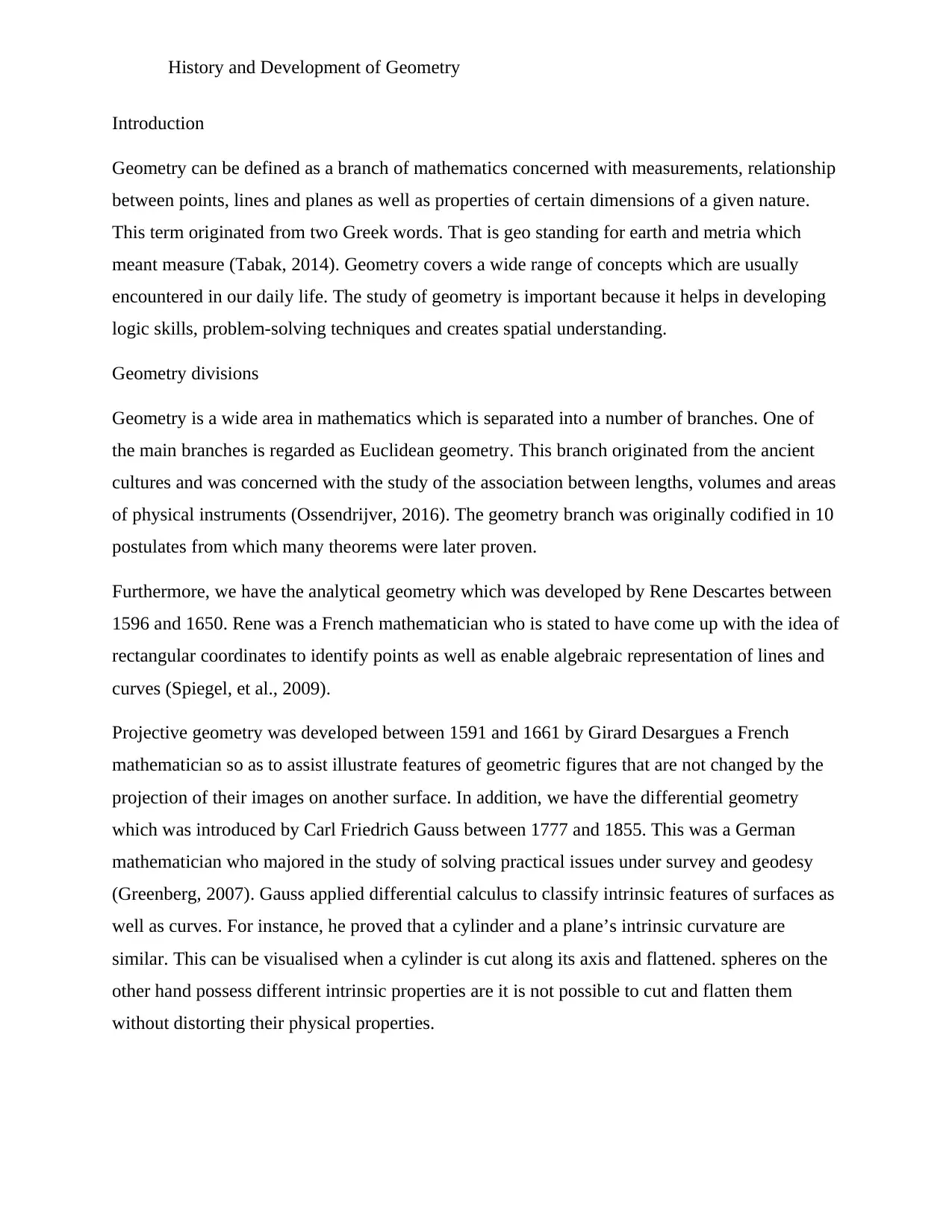
History and Development of Geometry
Introduction
Geometry can be defined as a branch of mathematics concerned with measurements, relationship
between points, lines and planes as well as properties of certain dimensions of a given nature.
This term originated from two Greek words. That is geo standing for earth and metria which
meant measure (Tabak, 2014). Geometry covers a wide range of concepts which are usually
encountered in our daily life. The study of geometry is important because it helps in developing
logic skills, problem-solving techniques and creates spatial understanding.
Geometry divisions
Geometry is a wide area in mathematics which is separated into a number of branches. One of
the main branches is regarded as Euclidean geometry. This branch originated from the ancient
cultures and was concerned with the study of the association between lengths, volumes and areas
of physical instruments (Ossendrijver, 2016). The geometry branch was originally codified in 10
postulates from which many theorems were later proven.
Furthermore, we have the analytical geometry which was developed by Rene Descartes between
1596 and 1650. Rene was a French mathematician who is stated to have come up with the idea of
rectangular coordinates to identify points as well as enable algebraic representation of lines and
curves (Spiegel, et al., 2009).
Projective geometry was developed between 1591 and 1661 by Girard Desargues a French
mathematician so as to assist illustrate features of geometric figures that are not changed by the
projection of their images on another surface. In addition, we have the differential geometry
which was introduced by Carl Friedrich Gauss between 1777 and 1855. This was a German
mathematician who majored in the study of solving practical issues under survey and geodesy
(Greenberg, 2007). Gauss applied differential calculus to classify intrinsic features of surfaces as
well as curves. For instance, he proved that a cylinder and a plane’s intrinsic curvature are
similar. This can be visualised when a cylinder is cut along its axis and flattened. spheres on the
other hand possess different intrinsic properties are it is not possible to cut and flatten them
without distorting their physical properties.
Introduction
Geometry can be defined as a branch of mathematics concerned with measurements, relationship
between points, lines and planes as well as properties of certain dimensions of a given nature.
This term originated from two Greek words. That is geo standing for earth and metria which
meant measure (Tabak, 2014). Geometry covers a wide range of concepts which are usually
encountered in our daily life. The study of geometry is important because it helps in developing
logic skills, problem-solving techniques and creates spatial understanding.
Geometry divisions
Geometry is a wide area in mathematics which is separated into a number of branches. One of
the main branches is regarded as Euclidean geometry. This branch originated from the ancient
cultures and was concerned with the study of the association between lengths, volumes and areas
of physical instruments (Ossendrijver, 2016). The geometry branch was originally codified in 10
postulates from which many theorems were later proven.
Furthermore, we have the analytical geometry which was developed by Rene Descartes between
1596 and 1650. Rene was a French mathematician who is stated to have come up with the idea of
rectangular coordinates to identify points as well as enable algebraic representation of lines and
curves (Spiegel, et al., 2009).
Projective geometry was developed between 1591 and 1661 by Girard Desargues a French
mathematician so as to assist illustrate features of geometric figures that are not changed by the
projection of their images on another surface. In addition, we have the differential geometry
which was introduced by Carl Friedrich Gauss between 1777 and 1855. This was a German
mathematician who majored in the study of solving practical issues under survey and geodesy
(Greenberg, 2007). Gauss applied differential calculus to classify intrinsic features of surfaces as
well as curves. For instance, he proved that a cylinder and a plane’s intrinsic curvature are
similar. This can be visualised when a cylinder is cut along its axis and flattened. spheres on the
other hand possess different intrinsic properties are it is not possible to cut and flatten them
without distorting their physical properties.
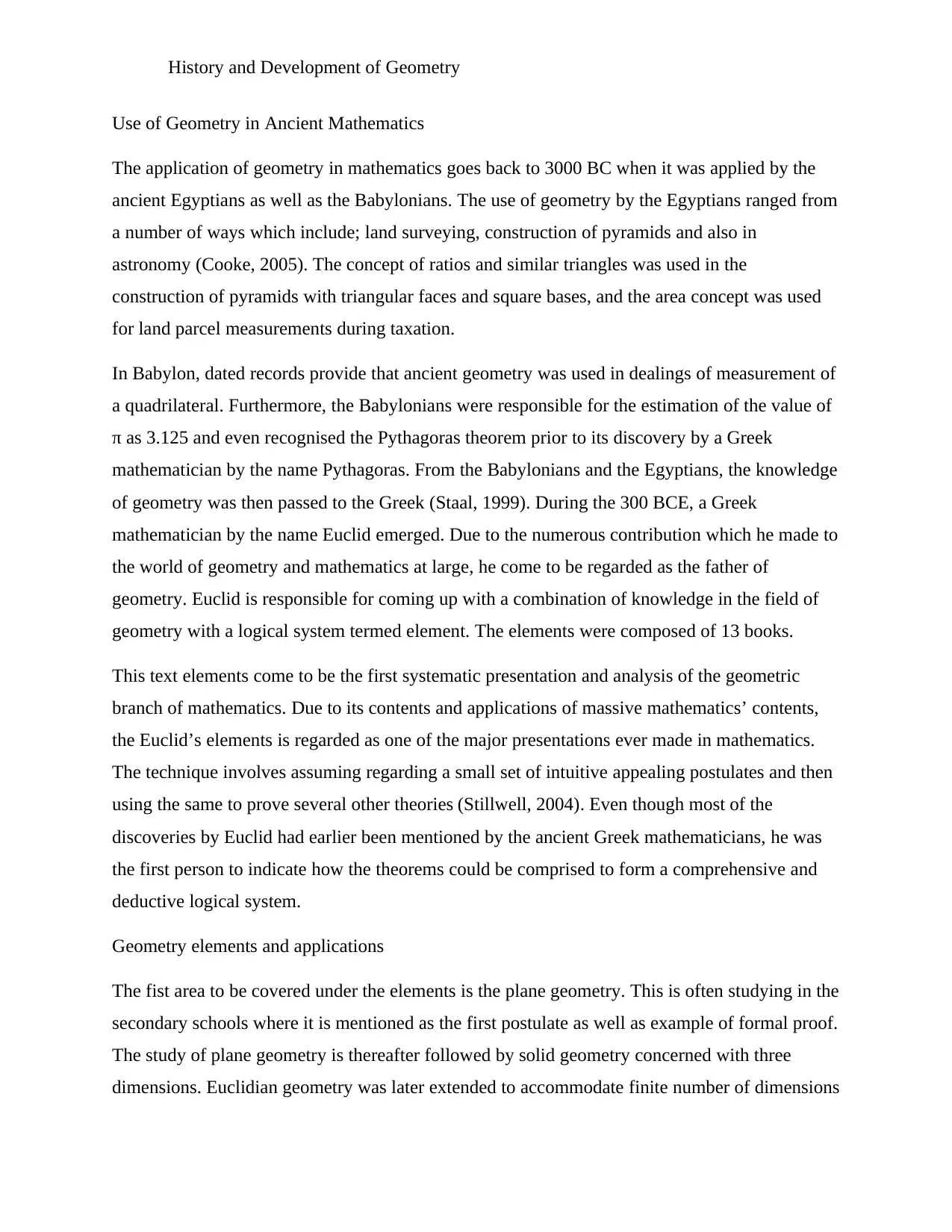
History and Development of Geometry
Use of Geometry in Ancient Mathematics
The application of geometry in mathematics goes back to 3000 BC when it was applied by the
ancient Egyptians as well as the Babylonians. The use of geometry by the Egyptians ranged from
a number of ways which include; land surveying, construction of pyramids and also in
astronomy (Cooke, 2005). The concept of ratios and similar triangles was used in the
construction of pyramids with triangular faces and square bases, and the area concept was used
for land parcel measurements during taxation.
In Babylon, dated records provide that ancient geometry was used in dealings of measurement of
a quadrilateral. Furthermore, the Babylonians were responsible for the estimation of the value of
π as 3.125 and even recognised the Pythagoras theorem prior to its discovery by a Greek
mathematician by the name Pythagoras. From the Babylonians and the Egyptians, the knowledge
of geometry was then passed to the Greek (Staal, 1999). During the 300 BCE, a Greek
mathematician by the name Euclid emerged. Due to the numerous contribution which he made to
the world of geometry and mathematics at large, he come to be regarded as the father of
geometry. Euclid is responsible for coming up with a combination of knowledge in the field of
geometry with a logical system termed element. The elements were composed of 13 books.
This text elements come to be the first systematic presentation and analysis of the geometric
branch of mathematics. Due to its contents and applications of massive mathematics’ contents,
the Euclid’s elements is regarded as one of the major presentations ever made in mathematics.
The technique involves assuming regarding a small set of intuitive appealing postulates and then
using the same to prove several other theories (Stillwell, 2004). Even though most of the
discoveries by Euclid had earlier been mentioned by the ancient Greek mathematicians, he was
the first person to indicate how the theorems could be comprised to form a comprehensive and
deductive logical system.
Geometry elements and applications
The fist area to be covered under the elements is the plane geometry. This is often studying in the
secondary schools where it is mentioned as the first postulate as well as example of formal proof.
The study of plane geometry is thereafter followed by solid geometry concerned with three
dimensions. Euclidian geometry was later extended to accommodate finite number of dimensions
Use of Geometry in Ancient Mathematics
The application of geometry in mathematics goes back to 3000 BC when it was applied by the
ancient Egyptians as well as the Babylonians. The use of geometry by the Egyptians ranged from
a number of ways which include; land surveying, construction of pyramids and also in
astronomy (Cooke, 2005). The concept of ratios and similar triangles was used in the
construction of pyramids with triangular faces and square bases, and the area concept was used
for land parcel measurements during taxation.
In Babylon, dated records provide that ancient geometry was used in dealings of measurement of
a quadrilateral. Furthermore, the Babylonians were responsible for the estimation of the value of
π as 3.125 and even recognised the Pythagoras theorem prior to its discovery by a Greek
mathematician by the name Pythagoras. From the Babylonians and the Egyptians, the knowledge
of geometry was then passed to the Greek (Staal, 1999). During the 300 BCE, a Greek
mathematician by the name Euclid emerged. Due to the numerous contribution which he made to
the world of geometry and mathematics at large, he come to be regarded as the father of
geometry. Euclid is responsible for coming up with a combination of knowledge in the field of
geometry with a logical system termed element. The elements were composed of 13 books.
This text elements come to be the first systematic presentation and analysis of the geometric
branch of mathematics. Due to its contents and applications of massive mathematics’ contents,
the Euclid’s elements is regarded as one of the major presentations ever made in mathematics.
The technique involves assuming regarding a small set of intuitive appealing postulates and then
using the same to prove several other theories (Stillwell, 2004). Even though most of the
discoveries by Euclid had earlier been mentioned by the ancient Greek mathematicians, he was
the first person to indicate how the theorems could be comprised to form a comprehensive and
deductive logical system.
Geometry elements and applications
The fist area to be covered under the elements is the plane geometry. This is often studying in the
secondary schools where it is mentioned as the first postulate as well as example of formal proof.
The study of plane geometry is thereafter followed by solid geometry concerned with three
dimensions. Euclidian geometry was later extended to accommodate finite number of dimensions
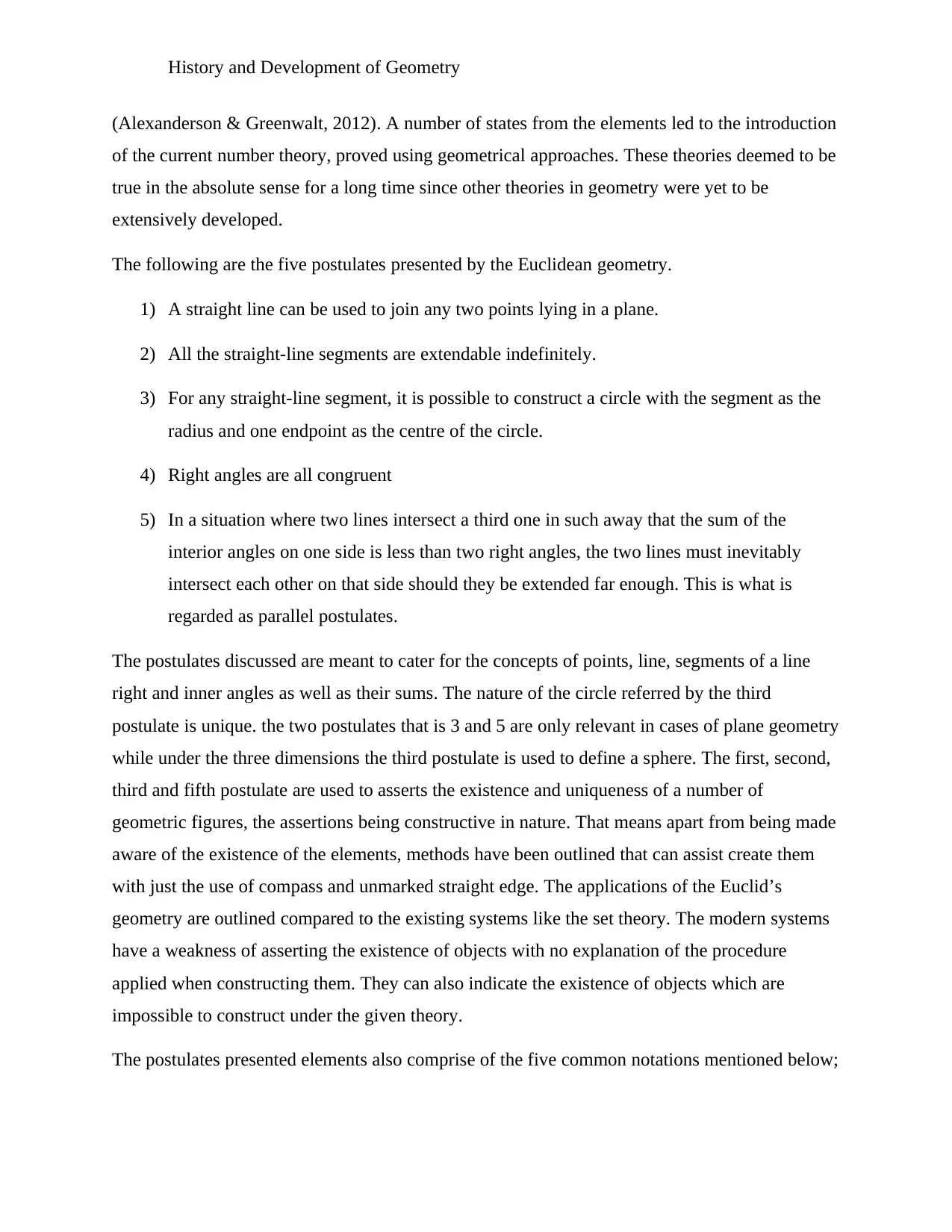
History and Development of Geometry
(Alexanderson & Greenwalt, 2012). A number of states from the elements led to the introduction
of the current number theory, proved using geometrical approaches. These theories deemed to be
true in the absolute sense for a long time since other theories in geometry were yet to be
extensively developed.
The following are the five postulates presented by the Euclidean geometry.
1) A straight line can be used to join any two points lying in a plane.
2) All the straight-line segments are extendable indefinitely.
3) For any straight-line segment, it is possible to construct a circle with the segment as the
radius and one endpoint as the centre of the circle.
4) Right angles are all congruent
5) In a situation where two lines intersect a third one in such away that the sum of the
interior angles on one side is less than two right angles, the two lines must inevitably
intersect each other on that side should they be extended far enough. This is what is
regarded as parallel postulates.
The postulates discussed are meant to cater for the concepts of points, line, segments of a line
right and inner angles as well as their sums. The nature of the circle referred by the third
postulate is unique. the two postulates that is 3 and 5 are only relevant in cases of plane geometry
while under the three dimensions the third postulate is used to define a sphere. The first, second,
third and fifth postulate are used to asserts the existence and uniqueness of a number of
geometric figures, the assertions being constructive in nature. That means apart from being made
aware of the existence of the elements, methods have been outlined that can assist create them
with just the use of compass and unmarked straight edge. The applications of the Euclid’s
geometry are outlined compared to the existing systems like the set theory. The modern systems
have a weakness of asserting the existence of objects with no explanation of the procedure
applied when constructing them. They can also indicate the existence of objects which are
impossible to construct under the given theory.
The postulates presented elements also comprise of the five common notations mentioned below;
(Alexanderson & Greenwalt, 2012). A number of states from the elements led to the introduction
of the current number theory, proved using geometrical approaches. These theories deemed to be
true in the absolute sense for a long time since other theories in geometry were yet to be
extensively developed.
The following are the five postulates presented by the Euclidean geometry.
1) A straight line can be used to join any two points lying in a plane.
2) All the straight-line segments are extendable indefinitely.
3) For any straight-line segment, it is possible to construct a circle with the segment as the
radius and one endpoint as the centre of the circle.
4) Right angles are all congruent
5) In a situation where two lines intersect a third one in such away that the sum of the
interior angles on one side is less than two right angles, the two lines must inevitably
intersect each other on that side should they be extended far enough. This is what is
regarded as parallel postulates.
The postulates discussed are meant to cater for the concepts of points, line, segments of a line
right and inner angles as well as their sums. The nature of the circle referred by the third
postulate is unique. the two postulates that is 3 and 5 are only relevant in cases of plane geometry
while under the three dimensions the third postulate is used to define a sphere. The first, second,
third and fifth postulate are used to asserts the existence and uniqueness of a number of
geometric figures, the assertions being constructive in nature. That means apart from being made
aware of the existence of the elements, methods have been outlined that can assist create them
with just the use of compass and unmarked straight edge. The applications of the Euclid’s
geometry are outlined compared to the existing systems like the set theory. The modern systems
have a weakness of asserting the existence of objects with no explanation of the procedure
applied when constructing them. They can also indicate the existence of objects which are
impossible to construct under the given theory.
The postulates presented elements also comprise of the five common notations mentioned below;
Secure Best Marks with AI Grader
Need help grading? Try our AI Grader for instant feedback on your assignments.
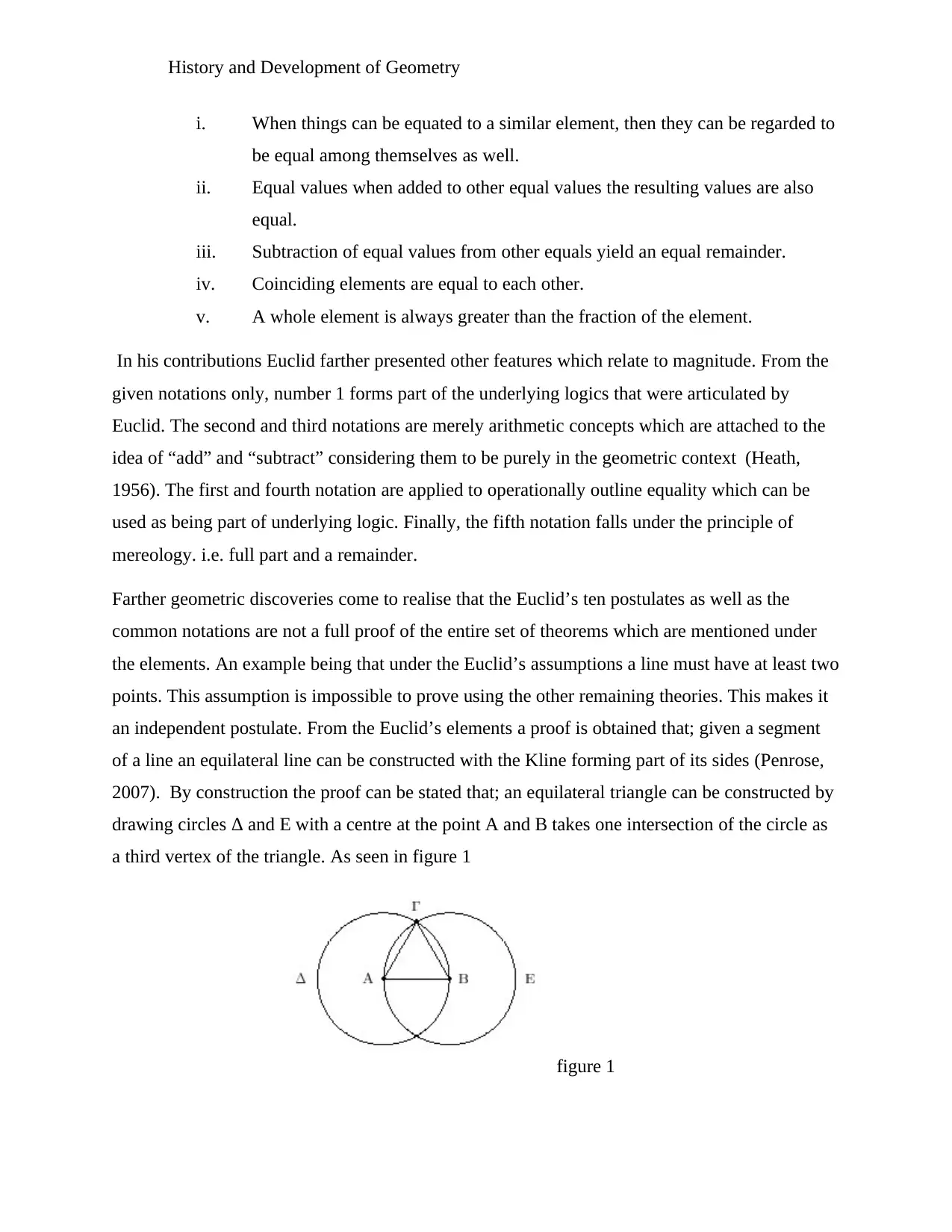
History and Development of Geometry
i. When things can be equated to a similar element, then they can be regarded to
be equal among themselves as well.
ii. Equal values when added to other equal values the resulting values are also
equal.
iii. Subtraction of equal values from other equals yield an equal remainder.
iv. Coinciding elements are equal to each other.
v. A whole element is always greater than the fraction of the element.
In his contributions Euclid farther presented other features which relate to magnitude. From the
given notations only, number 1 forms part of the underlying logics that were articulated by
Euclid. The second and third notations are merely arithmetic concepts which are attached to the
idea of “add” and “subtract” considering them to be purely in the geometric context (Heath,
1956). The first and fourth notation are applied to operationally outline equality which can be
used as being part of underlying logic. Finally, the fifth notation falls under the principle of
mereology. i.e. full part and a remainder.
Farther geometric discoveries come to realise that the Euclid’s ten postulates as well as the
common notations are not a full proof of the entire set of theorems which are mentioned under
the elements. An example being that under the Euclid’s assumptions a line must have at least two
points. This assumption is impossible to prove using the other remaining theories. This makes it
an independent postulate. From the Euclid’s elements a proof is obtained that; given a segment
of a line an equilateral line can be constructed with the Kline forming part of its sides (Penrose,
2007). By construction the proof can be stated that; an equilateral triangle can be constructed by
drawing circles Δ and Ε with a centre at the point A and B takes one intersection of the circle as
a third vertex of the triangle. As seen in figure 1
figure 1
i. When things can be equated to a similar element, then they can be regarded to
be equal among themselves as well.
ii. Equal values when added to other equal values the resulting values are also
equal.
iii. Subtraction of equal values from other equals yield an equal remainder.
iv. Coinciding elements are equal to each other.
v. A whole element is always greater than the fraction of the element.
In his contributions Euclid farther presented other features which relate to magnitude. From the
given notations only, number 1 forms part of the underlying logics that were articulated by
Euclid. The second and third notations are merely arithmetic concepts which are attached to the
idea of “add” and “subtract” considering them to be purely in the geometric context (Heath,
1956). The first and fourth notation are applied to operationally outline equality which can be
used as being part of underlying logic. Finally, the fifth notation falls under the principle of
mereology. i.e. full part and a remainder.
Farther geometric discoveries come to realise that the Euclid’s ten postulates as well as the
common notations are not a full proof of the entire set of theorems which are mentioned under
the elements. An example being that under the Euclid’s assumptions a line must have at least two
points. This assumption is impossible to prove using the other remaining theories. This makes it
an independent postulate. From the Euclid’s elements a proof is obtained that; given a segment
of a line an equilateral line can be constructed with the Kline forming part of its sides (Penrose,
2007). By construction the proof can be stated that; an equilateral triangle can be constructed by
drawing circles Δ and Ε with a centre at the point A and B takes one intersection of the circle as
a third vertex of the triangle. As seen in figure 1
figure 1
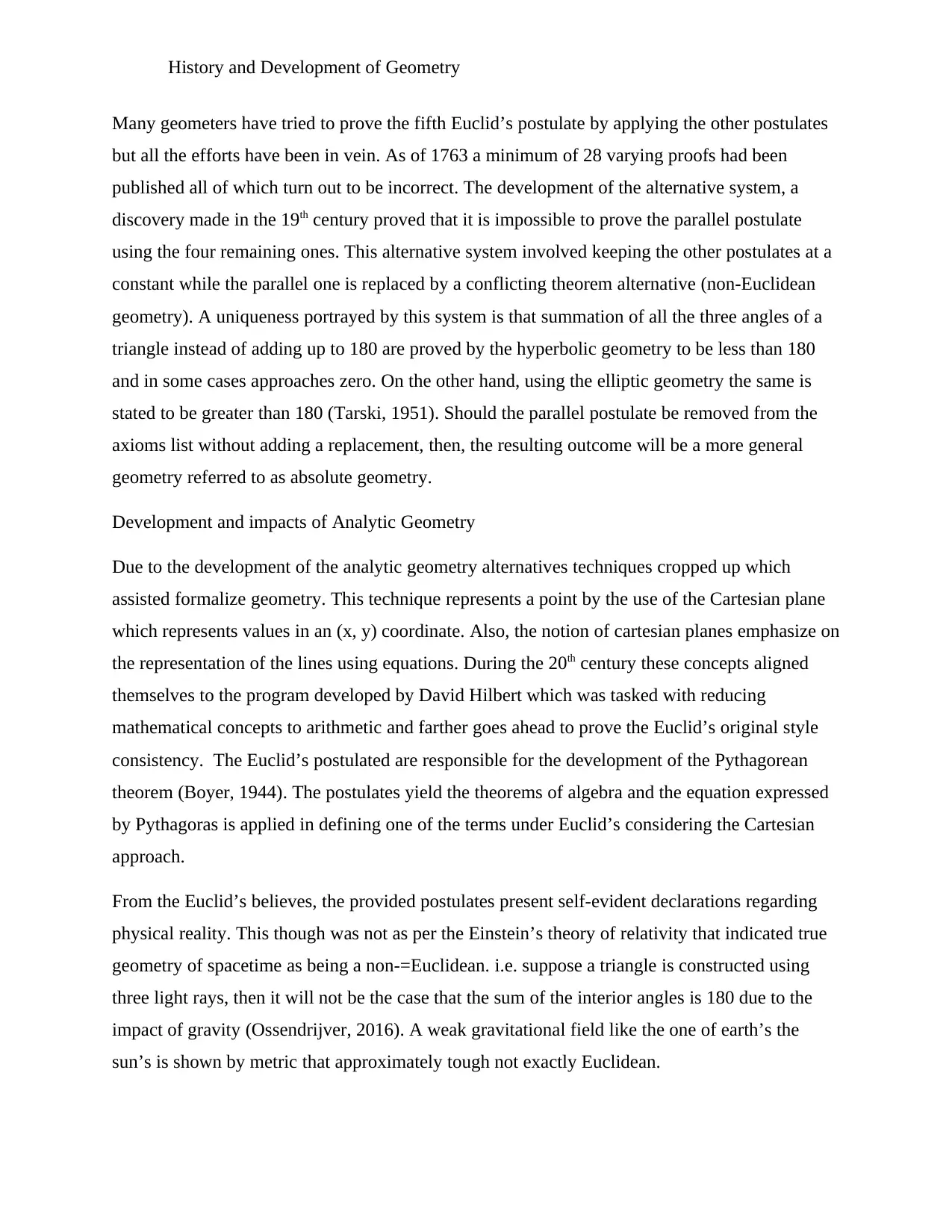
History and Development of Geometry
Many geometers have tried to prove the fifth Euclid’s postulate by applying the other postulates
but all the efforts have been in vein. As of 1763 a minimum of 28 varying proofs had been
published all of which turn out to be incorrect. The development of the alternative system, a
discovery made in the 19th century proved that it is impossible to prove the parallel postulate
using the four remaining ones. This alternative system involved keeping the other postulates at a
constant while the parallel one is replaced by a conflicting theorem alternative (non-Euclidean
geometry). A uniqueness portrayed by this system is that summation of all the three angles of a
triangle instead of adding up to 180 are proved by the hyperbolic geometry to be less than 180
and in some cases approaches zero. On the other hand, using the elliptic geometry the same is
stated to be greater than 180 (Tarski, 1951). Should the parallel postulate be removed from the
axioms list without adding a replacement, then, the resulting outcome will be a more general
geometry referred to as absolute geometry.
Development and impacts of Analytic Geometry
Due to the development of the analytic geometry alternatives techniques cropped up which
assisted formalize geometry. This technique represents a point by the use of the Cartesian plane
which represents values in an (x, y) coordinate. Also, the notion of cartesian planes emphasize on
the representation of the lines using equations. During the 20th century these concepts aligned
themselves to the program developed by David Hilbert which was tasked with reducing
mathematical concepts to arithmetic and farther goes ahead to prove the Euclid’s original style
consistency. The Euclid’s postulated are responsible for the development of the Pythagorean
theorem (Boyer, 1944). The postulates yield the theorems of algebra and the equation expressed
by Pythagoras is applied in defining one of the terms under Euclid’s considering the Cartesian
approach.
From the Euclid’s believes, the provided postulates present self-evident declarations regarding
physical reality. This though was not as per the Einstein’s theory of relativity that indicated true
geometry of spacetime as being a non-=Euclidean. i.e. suppose a triangle is constructed using
three light rays, then it will not be the case that the sum of the interior angles is 180 due to the
impact of gravity (Ossendrijver, 2016). A weak gravitational field like the one of earth’s the
sun’s is shown by metric that approximately tough not exactly Euclidean.
Many geometers have tried to prove the fifth Euclid’s postulate by applying the other postulates
but all the efforts have been in vein. As of 1763 a minimum of 28 varying proofs had been
published all of which turn out to be incorrect. The development of the alternative system, a
discovery made in the 19th century proved that it is impossible to prove the parallel postulate
using the four remaining ones. This alternative system involved keeping the other postulates at a
constant while the parallel one is replaced by a conflicting theorem alternative (non-Euclidean
geometry). A uniqueness portrayed by this system is that summation of all the three angles of a
triangle instead of adding up to 180 are proved by the hyperbolic geometry to be less than 180
and in some cases approaches zero. On the other hand, using the elliptic geometry the same is
stated to be greater than 180 (Tarski, 1951). Should the parallel postulate be removed from the
axioms list without adding a replacement, then, the resulting outcome will be a more general
geometry referred to as absolute geometry.
Development and impacts of Analytic Geometry
Due to the development of the analytic geometry alternatives techniques cropped up which
assisted formalize geometry. This technique represents a point by the use of the Cartesian plane
which represents values in an (x, y) coordinate. Also, the notion of cartesian planes emphasize on
the representation of the lines using equations. During the 20th century these concepts aligned
themselves to the program developed by David Hilbert which was tasked with reducing
mathematical concepts to arithmetic and farther goes ahead to prove the Euclid’s original style
consistency. The Euclid’s postulated are responsible for the development of the Pythagorean
theorem (Boyer, 1944). The postulates yield the theorems of algebra and the equation expressed
by Pythagoras is applied in defining one of the terms under Euclid’s considering the Cartesian
approach.
From the Euclid’s believes, the provided postulates present self-evident declarations regarding
physical reality. This though was not as per the Einstein’s theory of relativity that indicated true
geometry of spacetime as being a non-=Euclidean. i.e. suppose a triangle is constructed using
three light rays, then it will not be the case that the sum of the interior angles is 180 due to the
impact of gravity (Ossendrijver, 2016). A weak gravitational field like the one of earth’s the
sun’s is shown by metric that approximately tough not exactly Euclidean.
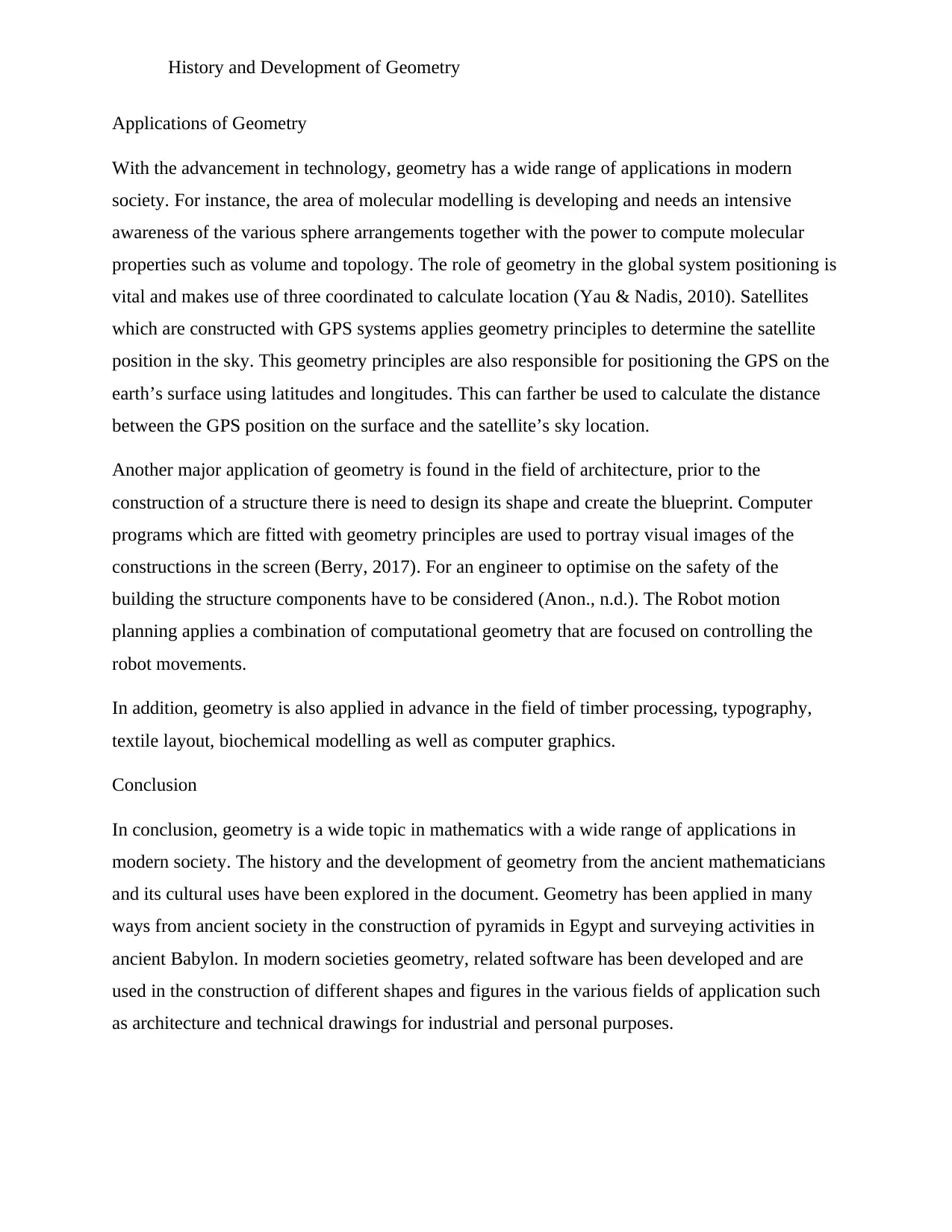
History and Development of Geometry
Applications of Geometry
With the advancement in technology, geometry has a wide range of applications in modern
society. For instance, the area of molecular modelling is developing and needs an intensive
awareness of the various sphere arrangements together with the power to compute molecular
properties such as volume and topology. The role of geometry in the global system positioning is
vital and makes use of three coordinated to calculate location (Yau & Nadis, 2010). Satellites
which are constructed with GPS systems applies geometry principles to determine the satellite
position in the sky. This geometry principles are also responsible for positioning the GPS on the
earth’s surface using latitudes and longitudes. This can farther be used to calculate the distance
between the GPS position on the surface and the satellite’s sky location.
Another major application of geometry is found in the field of architecture, prior to the
construction of a structure there is need to design its shape and create the blueprint. Computer
programs which are fitted with geometry principles are used to portray visual images of the
constructions in the screen (Berry, 2017). For an engineer to optimise on the safety of the
building the structure components have to be considered (Anon., n.d.). The Robot motion
planning applies a combination of computational geometry that are focused on controlling the
robot movements.
In addition, geometry is also applied in advance in the field of timber processing, typography,
textile layout, biochemical modelling as well as computer graphics.
Conclusion
In conclusion, geometry is a wide topic in mathematics with a wide range of applications in
modern society. The history and the development of geometry from the ancient mathematicians
and its cultural uses have been explored in the document. Geometry has been applied in many
ways from ancient society in the construction of pyramids in Egypt and surveying activities in
ancient Babylon. In modern societies geometry, related software has been developed and are
used in the construction of different shapes and figures in the various fields of application such
as architecture and technical drawings for industrial and personal purposes.
Applications of Geometry
With the advancement in technology, geometry has a wide range of applications in modern
society. For instance, the area of molecular modelling is developing and needs an intensive
awareness of the various sphere arrangements together with the power to compute molecular
properties such as volume and topology. The role of geometry in the global system positioning is
vital and makes use of three coordinated to calculate location (Yau & Nadis, 2010). Satellites
which are constructed with GPS systems applies geometry principles to determine the satellite
position in the sky. This geometry principles are also responsible for positioning the GPS on the
earth’s surface using latitudes and longitudes. This can farther be used to calculate the distance
between the GPS position on the surface and the satellite’s sky location.
Another major application of geometry is found in the field of architecture, prior to the
construction of a structure there is need to design its shape and create the blueprint. Computer
programs which are fitted with geometry principles are used to portray visual images of the
constructions in the screen (Berry, 2017). For an engineer to optimise on the safety of the
building the structure components have to be considered (Anon., n.d.). The Robot motion
planning applies a combination of computational geometry that are focused on controlling the
robot movements.
In addition, geometry is also applied in advance in the field of timber processing, typography,
textile layout, biochemical modelling as well as computer graphics.
Conclusion
In conclusion, geometry is a wide topic in mathematics with a wide range of applications in
modern society. The history and the development of geometry from the ancient mathematicians
and its cultural uses have been explored in the document. Geometry has been applied in many
ways from ancient society in the construction of pyramids in Egypt and surveying activities in
ancient Babylon. In modern societies geometry, related software has been developed and are
used in the construction of different shapes and figures in the various fields of application such
as architecture and technical drawings for industrial and personal purposes.
Paraphrase This Document
Need a fresh take? Get an instant paraphrase of this document with our AI Paraphraser
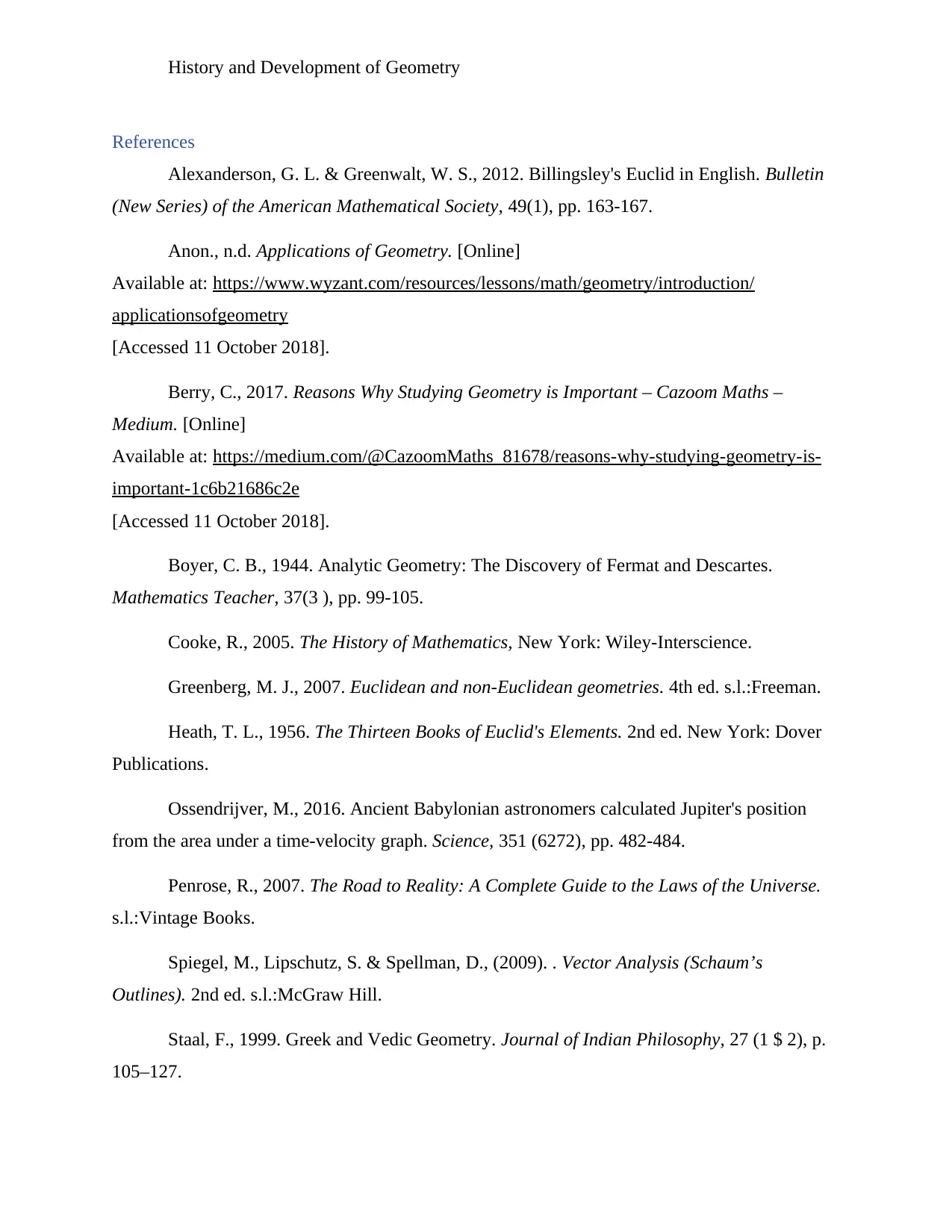
History and Development of Geometry
References
Alexanderson, G. L. & Greenwalt, W. S., 2012. Billingsley's Euclid in English. Bulletin
(New Series) of the American Mathematical Society, 49(1), pp. 163-167.
Anon., n.d. Applications of Geometry. [Online]
Available at: https://www.wyzant.com/resources/lessons/math/geometry/introduction/
applicationsofgeometry
[Accessed 11 October 2018].
Berry, C., 2017. Reasons Why Studying Geometry is Important – Cazoom Maths –
Medium. [Online]
Available at: https://medium.com/@CazoomMaths_81678/reasons-why-studying-geometry-is-
important-1c6b21686c2e
[Accessed 11 October 2018].
Boyer, C. B., 1944. Analytic Geometry: The Discovery of Fermat and Descartes.
Mathematics Teacher, 37(3 ), pp. 99-105.
Cooke, R., 2005. The History of Mathematics, New York: Wiley-Interscience.
Greenberg, M. J., 2007. Euclidean and non-Euclidean geometries. 4th ed. s.l.:Freeman.
Heath, T. L., 1956. The Thirteen Books of Euclid's Elements. 2nd ed. New York: Dover
Publications.
Ossendrijver, M., 2016. Ancient Babylonian astronomers calculated Jupiter's position
from the area under a time-velocity graph. Science, 351 (6272), pp. 482-484.
Penrose, R., 2007. The Road to Reality: A Complete Guide to the Laws of the Universe.
s.l.:Vintage Books.
Spiegel, M., Lipschutz, S. & Spellman, D., (2009). . Vector Analysis (Schaum’s
Outlines). 2nd ed. s.l.:McGraw Hill.
Staal, F., 1999. Greek and Vedic Geometry. Journal of Indian Philosophy, 27 (1 $ 2), p.
105–127.
References
Alexanderson, G. L. & Greenwalt, W. S., 2012. Billingsley's Euclid in English. Bulletin
(New Series) of the American Mathematical Society, 49(1), pp. 163-167.
Anon., n.d. Applications of Geometry. [Online]
Available at: https://www.wyzant.com/resources/lessons/math/geometry/introduction/
applicationsofgeometry
[Accessed 11 October 2018].
Berry, C., 2017. Reasons Why Studying Geometry is Important – Cazoom Maths –
Medium. [Online]
Available at: https://medium.com/@CazoomMaths_81678/reasons-why-studying-geometry-is-
important-1c6b21686c2e
[Accessed 11 October 2018].
Boyer, C. B., 1944. Analytic Geometry: The Discovery of Fermat and Descartes.
Mathematics Teacher, 37(3 ), pp. 99-105.
Cooke, R., 2005. The History of Mathematics, New York: Wiley-Interscience.
Greenberg, M. J., 2007. Euclidean and non-Euclidean geometries. 4th ed. s.l.:Freeman.
Heath, T. L., 1956. The Thirteen Books of Euclid's Elements. 2nd ed. New York: Dover
Publications.
Ossendrijver, M., 2016. Ancient Babylonian astronomers calculated Jupiter's position
from the area under a time-velocity graph. Science, 351 (6272), pp. 482-484.
Penrose, R., 2007. The Road to Reality: A Complete Guide to the Laws of the Universe.
s.l.:Vintage Books.
Spiegel, M., Lipschutz, S. & Spellman, D., (2009). . Vector Analysis (Schaum’s
Outlines). 2nd ed. s.l.:McGraw Hill.
Staal, F., 1999. Greek and Vedic Geometry. Journal of Indian Philosophy, 27 (1 $ 2), p.
105–127.
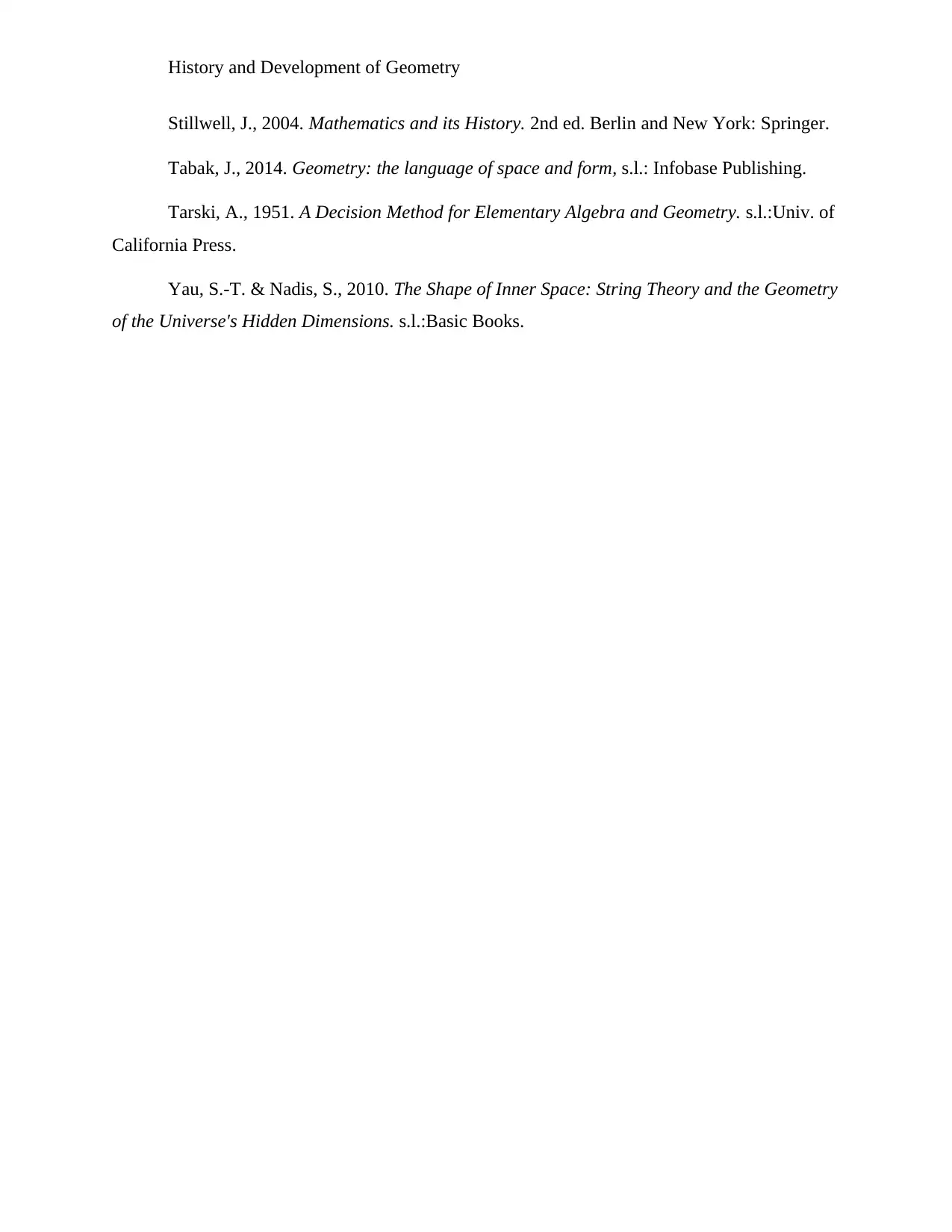
History and Development of Geometry
Stillwell, J., 2004. Mathematics and its History. 2nd ed. Berlin and New York: Springer.
Tabak, J., 2014. Geometry: the language of space and form, s.l.: Infobase Publishing.
Tarski, A., 1951. A Decision Method for Elementary Algebra and Geometry. s.l.:Univ. of
California Press.
Yau, S.-T. & Nadis, S., 2010. The Shape of Inner Space: String Theory and the Geometry
of the Universe's Hidden Dimensions. s.l.:Basic Books.
Stillwell, J., 2004. Mathematics and its History. 2nd ed. Berlin and New York: Springer.
Tabak, J., 2014. Geometry: the language of space and form, s.l.: Infobase Publishing.
Tarski, A., 1951. A Decision Method for Elementary Algebra and Geometry. s.l.:Univ. of
California Press.
Yau, S.-T. & Nadis, S., 2010. The Shape of Inner Space: String Theory and the Geometry
of the Universe's Hidden Dimensions. s.l.:Basic Books.
1 out of 9
Your All-in-One AI-Powered Toolkit for Academic Success.
+13062052269
info@desklib.com
Available 24*7 on WhatsApp / Email
![[object Object]](/_next/static/media/star-bottom.7253800d.svg)
Unlock your academic potential
© 2024 | Zucol Services PVT LTD | All rights reserved.